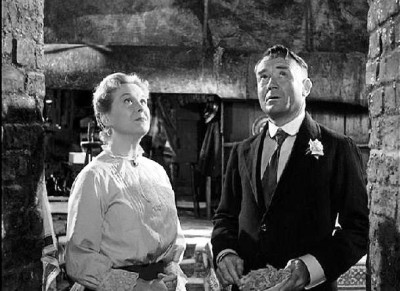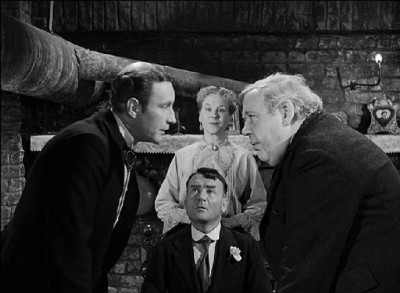
Today when you hear the name David Lean, the immediate tendency is to think of those sprawling epics like The Bridge on the River Kwai (1957) or Lawrence of Arabia (1962) or Doctor Zhivago (1965). But it’s worth remembering that before those, Lean had established himself as a filmmaker of considerable skill. In fact, it was that skill that allowed him to make that rarest of things, the intelligent epic. Just before he went all Technicolored travelogue with Katharine Hepburn in Summertime (1955), he made one final, truly small-scale black-and-white studio film, Hobson’s Choice—and as filmmaking, it’s a fine as anything he ever made. (Frankly, I’d rather watch it than many of his “big” pictures.) There’s not much to it really. It’s a simple period comedy (it had already been filmed twice before in 1920 and 1931) about Henry Hobson (Charles Laughton), a not-all-that-genial dipsomaniac with a high-end boot and shoe shop and three unmarried daughters. Hobson is something of a tyrant—a tyrant who refuses to provide dowries for his daughters, effectively condemning them to life as unpaid help in his shop.

The oldest, Maggie (Brenda de Banzie), who is generally considered unmarriageable (because she’s 30), has other ideas. She plans on making her father’s timid (but brilliant at his job) bootmaker Willie Mossop (John Mills) and making something of him. Her father, of course, is dead set against this, and Willie isn’t keen on the idea either. Neither of these things makes the slightest difference to Maggie, who is resolute in her plans. And, truth to tell, she is a force of nature, but an ultimately likable one. The film is clearly designed as a vehicle for Laughton, and while he’s very good in what can only be described as a Laughtonesque manner, it’s really more about Maggie and Willie. They form the dramatic arc of the film and are the more complex characters. John Mills’ transformation from rabbit to man is a joy to behold—not in the least because the rabbit keeps threatening to show through.

So much of what makes Hobson’s Choice work, however, is Lean’s filmmaking craftsmanship. I do not believe there’s a single throwaway shot in the film. Every composition and camera move is designed for the greatest impact. You can see this from the very first shot and the subsequent—and incredible—moving shot that travels through the shoe shop. Oh, sure, a static shot—or a series of them—would have essentially conveyed the same information, but what Lean does sings. It so completely inhabits the little world of the shop that you can almost smell the leather. Lean never lets up either—everything is just a little bit better than it has to be. And that’s the key to his greatness.
Classic World Cinema by Courtyard Gallery will present Hobson’s Choice Friday, Mar. 7, at 8 p.m. at Phil Mechanic Studios, 109 Roberts St., River Arts District (upstairs in the Railroad Library). Info: 273-3332, www.ashevillecourtyard.com




Before you comment
The comments section is here to provide a platform for civil dialogue on the issues we face together as a local community. Xpress is committed to offering this platform for all voices, but when the tone of the discussion gets nasty or strays off topic, we believe many people choose not to participate. Xpress editors are determined to moderate comments to ensure a constructive interchange is maintained. All comments judged not to be in keeping with the spirit of civil discourse will be removed and repeat violators will be banned. See here for our terms of service. Thank you for being part of this effort to promote respectful discussion.